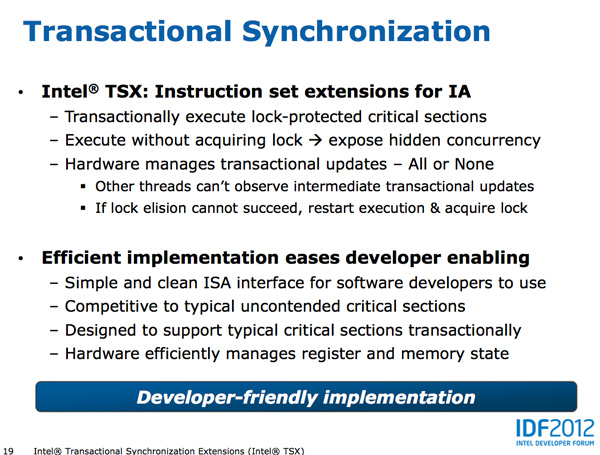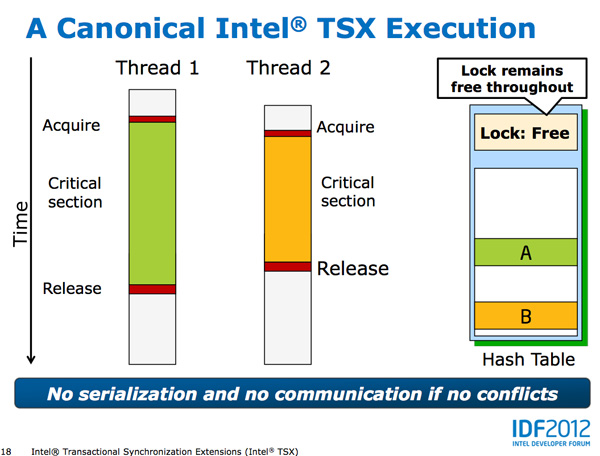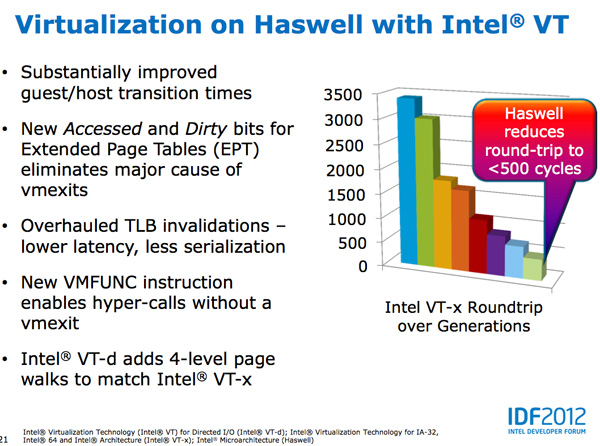Intel's Haswell Architecture Analyzed: Building a New PC and a New Intel
by Anand Lal Shimpi on October 5, 2012 2:45 AM ESTTSX
Johan did a great job explaining Haswell's Transactional Synchronization eXtensions (TSX), so I won't go into as much depth here. The basic premise is simple, although the implementation is quite complex.
It's easy to demand well threaded applications from software vendors, but actually implementing code that scales well across unlimited threads isn't easy. Parallelizing truly independent tasks is the low hanging fruit, but it's the tasks that all access the same data structure that can create problems. With multiple cores accessing the same data structure, running independent of one another, there's the risk of two different cores writing to the same part of the same structure. Only one set of data can be right, but dealing with this concurrent access problem can get hairy.
The simplest way to deal with it is simply to lock the entire data structure as soon as one core starts accessing it and only allow that one core write access until it's done. Other cores are given access to the data structure, but serially, not in parallel to avoid any data integrity issues.
This is by far the easiest way to deal with the problem of multiple threads accessing the same data structure, however it also prevents any performance scaling across multiple threads/cores. As focused as Intel is on increasing single threaded performance, a lot of die area goes wasted if applications don't scale well with more cores.
Software developers can instead choose to implement more fine grained locking of data structures, however doing so obviously increases the complexity of their code.
Haswell's TSX instructions allow the developer to shift much of the complexity of managing locks to the CPU. Using the new Hardware Lock Elision and its XAQUIRE/XRELEASE instructions, Haswell developers can mark a section of code for transactional execution. Haswell will then execute the code as if no hardware locks were in place and if it completes without issues the CPU will commit all writes to memory and enjoy the performance benefits. If two or more threads attempt to write to the same area in memory, the process is aborted and code re-executed traditionally with locks. The XAQUIRE/XRELEASE instructions decode to no-ops on earlier architectures so backwards compatibility isn't a problem.
Like most new instructions, it's going to take a while for Haswell's TSX to take off as we'll need to see significant adoption of Haswell platforms as well as developers embracing the new instructions. TSX does stand to show improvements in performance anywhere from client to server performance if implemented however, this is definitely one to watch for and be excited about.
Haswell also continues improvements in virtualization performance, including big decreases to guest/host transition times.














245 Comments
View All Comments
defiler99 - Tuesday, October 16, 2012 - link
One of the best articles on Anandtech in some time. This is great original tech industry reporting.Gc - Saturday, January 12, 2013 - link
Congratulations, an intel cpu engineer wrote around 27 Dec 2012:"... Anandtech's latest Haswell preview is also excellent; missing some key puzzle pieces to complete the picture and answer some open questions or correct some details but otherwise great. ..."
http://www.reddit.com/r/IAmA/comments/15iaet/iama_...
xaml - Thursday, May 23, 2013 - link
This was first posted here a few handfuls of pages back as a comment by user "telephone". ^^yhselp - Friday, March 29, 2013 - link
A few questions.Is there going to be a replacement (37W) for the current IVB 35W quad-core part? Quite a few designs are now dependable on this, lower power quad-core option - Sony S-series and Razer Blade, to name a few.
When can we expect all mobile CPUs (except maybe for the extreme series) to fall into the 10W-20W range? In three years' time and 10nm?
The decision to not include GT3 with desktop parts is very disappointing. A 35/45W low-voltage part with GT3 would make for an excellent HTPC build, among other things. Is there a chance Intel change their mind and start shipping GT3 desktop parts at some point?
JVimes - Tuesday, August 19, 2014 - link
Does EU stand for Execution Unit? That was surprisingly hard to google for.